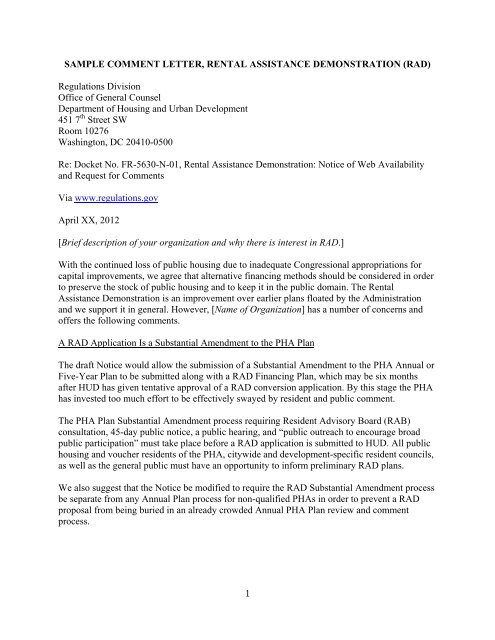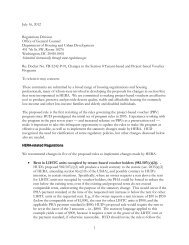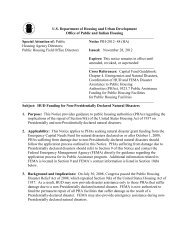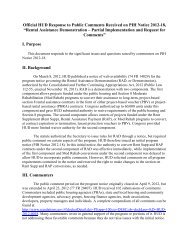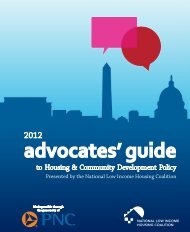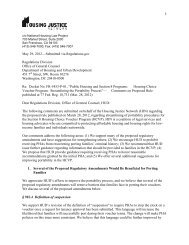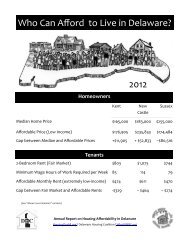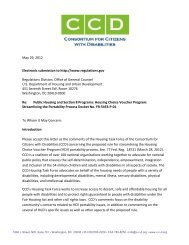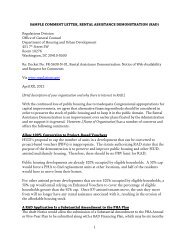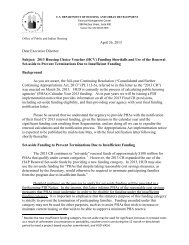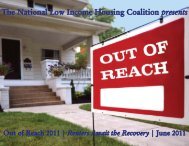RAD Sample Comment Letter
RAD Sample Comment Letter
RAD Sample Comment Letter
Create successful ePaper yourself
Turn your PDF publications into a flip-book with our unique Google optimized e-Paper software.
SAMPLE COMMENT LETTER, RENTAL ASSISTANCE DEMONSTRATION (<strong>RAD</strong>)Regulations DivisionOffice of General CounselDepartment of Housing and Urban Development451 7 th Street SWRoom 10276Washington, DC 20410-0500Re: Docket No. FR-5630-N-01, Rental Assistance Demonstration: Notice of Web Availabilityand Request for <strong>Comment</strong>sVia www.regulations.govApril XX, 2012[Brief description of your organization and why there is interest in <strong>RAD</strong>.]With the continued loss of public housing due to inadequate Congressional appropriations forcapital improvements, we agree that alternative financing methods should be considered in orderto preserve the stock of public housing and to keep it in the public domain. The RentalAssistance Demonstration is an improvement over earlier plans floated by the Administrationand we support it in general. However, [Name of Organization] has a number of concerns andoffers the following comments.A <strong>RAD</strong> Application Is a Substantial Amendment to the PHA PlanThe draft Notice would allow the submission of a Substantial Amendment to the PHA Annual orFive-Year Plan to be submitted along with a <strong>RAD</strong> Financing Plan, which may be six monthsafter HUD has given tentative approval of a <strong>RAD</strong> conversion application. By this stage the PHAhas invested too much effort to be effectively swayed by resident and public comment.The PHA Plan Substantial Amendment process requiring Resident Advisory Board (RAB)consultation, 45-day public notice, a public hearing, and “public outreach to encourage broadpublic participation” must take place before a <strong>RAD</strong> application is submitted to HUD. All publichousing and voucher residents of the PHA, citywide and development-specific resident councils,as well as the general public must have an opportunity to inform preliminary <strong>RAD</strong> plans.We also suggest that the Notice be modified to require the <strong>RAD</strong> Substantial Amendment processbe separate from any Annual Plan process for non-qualified PHAs in order to prevent a <strong>RAD</strong>proposal from being buried in an already crowded Annual PHA Plan review and commentprocess.1
Continuous Resident and Public ParticipationOngoing, full resident and public engagement should be required before each <strong>RAD</strong> conversionmilestone to ensure that when decisions must be made and when changes to the plan need to bemade, the RAB, all public housing and voucher residents, and the public, have an opportunity toreview and comment.After conversion, developments converted to project-based rental assistance (PBRA) shouldremain subject to the PHA Plan process, the development’s resident organization should beallowed to join a jurisdiction wide resident organization, and any of the development’s residentsshould be allowed to serve on the PHA Board of Commissioners.$25 Per Unit Fund For Resident ParticipationThe Notice requires PHAs and owners of converted properties to continue to provide $25 peroccupied unit annually for resident participation. Although the regulations only require $15 ofthis to be directly provided to a resident organization, PIH Notice 2001-3 remains in effect anddirects the full $25 to be controlled by resident councils. The <strong>RAD</strong> Notice should continue tofollow PIH Notice 2001-3.Technical Assistance for ResidentsHUD must provide residents and resident organizations with sufficient resources to enable themto obtain technical assistance to help them understand and effectively participate in the <strong>RAD</strong>process.Grievance ProceduresThe <strong>RAD</strong> notice only refers to the use of a grievance hearing when an owner terminates atenancy. <strong>RAD</strong> should explicitly provide for the right to grieve PHA or owner inactions as well asactions that adversely affect residents such as rent adjustment, transfer denial, change inhousehold composition, and serious housing quality problems, among others.HUD has long required a two-step process that first calls for an informal grievance settlement,followed if necessary by a hearing. The first step often results in resolving problems without theneed for a more formal grievance hearing. For <strong>RAD</strong>, HUD should require an informal grievanceresolution stage in addition to providing for the proposed hearing process for those cases thatcannot be resolved. In addition, the grievance hearing must include all of the components in thepublic housing grievance regulations.2
One-for-One ReplacementThe Notice ought to clearly state that the purpose of <strong>RAD</strong> is to preserve assisted, affordablerental housing, and that there must be one-for-one replacement if units are lost in excess of the“de minimis” standard of 5% of a project’s units or five units, whichever is greater.HUD should remove the provision allowing unlimited demolition, without HUD approval andwithout one-for-one replacement, of units that have been vacant for more than two years or thatare beyond reasonable repair.Allow 100% of the Units in a Development to be Converted to Project-Based VouchersHUD’s proposal to raise the cap on the number of units in a development using PBVs from 25%to 50% is insufficient. In the <strong>RAD</strong> context there should be no limit because the public housingdevelopments to be converted are already 100% occupied by eligible households. A 50% capwould force a PHA to find replacement units at other locations, and half of the residents wouldhave to move from their homes.Ownership of Converted UnitsIf a <strong>RAD</strong>-converted property is threatened with foreclosure, the <strong>RAD</strong> law requires HUD toensure that ownership is transferred to a public entity, and if that is not possible, then to a privateentity. The Notice should specify that among private entities, preference should be given tononprofit owners, with an additional preference for tenant organizations. Only after these fouroptions have failed should other forms of private ownership be sought.Choice MobilityHUD should give significant ranking points to applications that commit to provide mobilitycounseling, landlord outreach, enhanced rents in high opportunity areas, and other activities thatfacilitate choice mobility. Additional ranking points should be awarded to PHAs that commit toproviding a percentage of choice mobility vouchers greater than the Notice’s cap of one-third ofturnover vouchers or 20% of a project’s assisted units.For units converted to PBRA, a PHA should be required to honor all eligible choice mobilityrequests, at least up to a level of one-third of the PHA’s turnover vouchers.The Notice proposes an exemption from the choice mobility requirement for up to 10% of allunits in the <strong>RAD</strong> program for PHAs that do not administer a voucher program or that set asidemore than one-third of their vouchers for veterans or homeless people. If HUD awards <strong>RAD</strong>status to an exempt PHA its residents would have no choice mobility. Therefore, HUD mustrequire an exempt PHA to provide for some forms of mobility for current and future <strong>RAD</strong>residents.3


